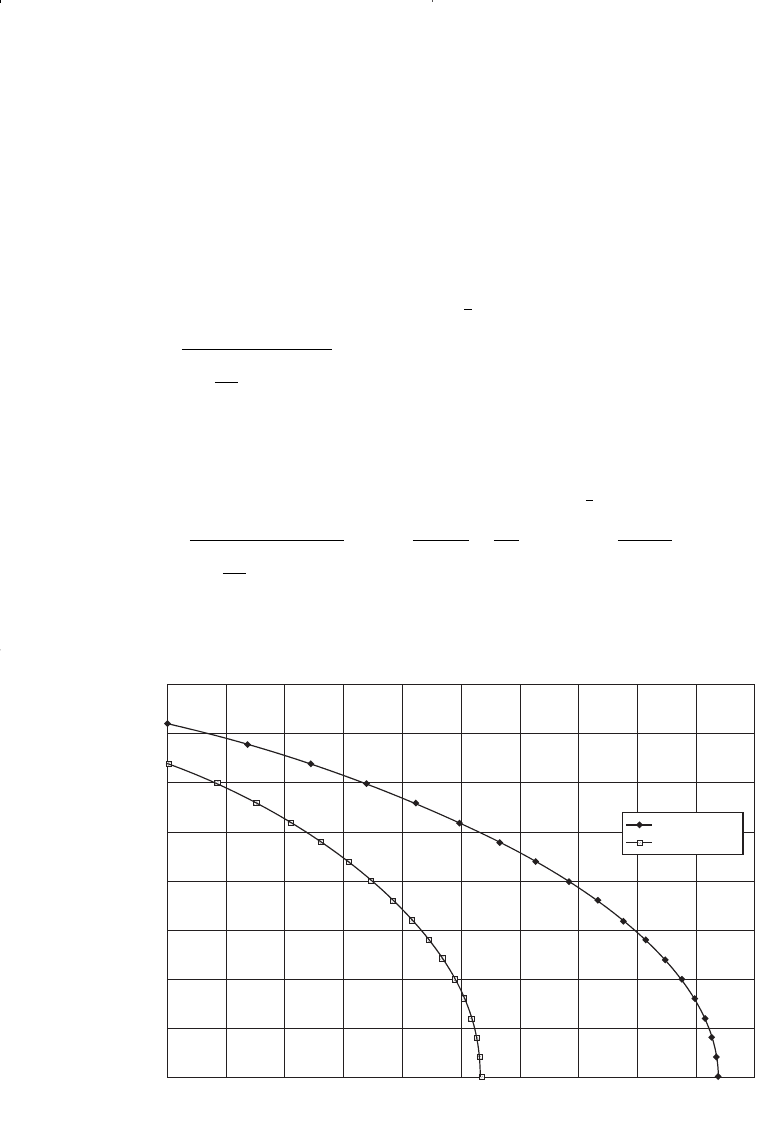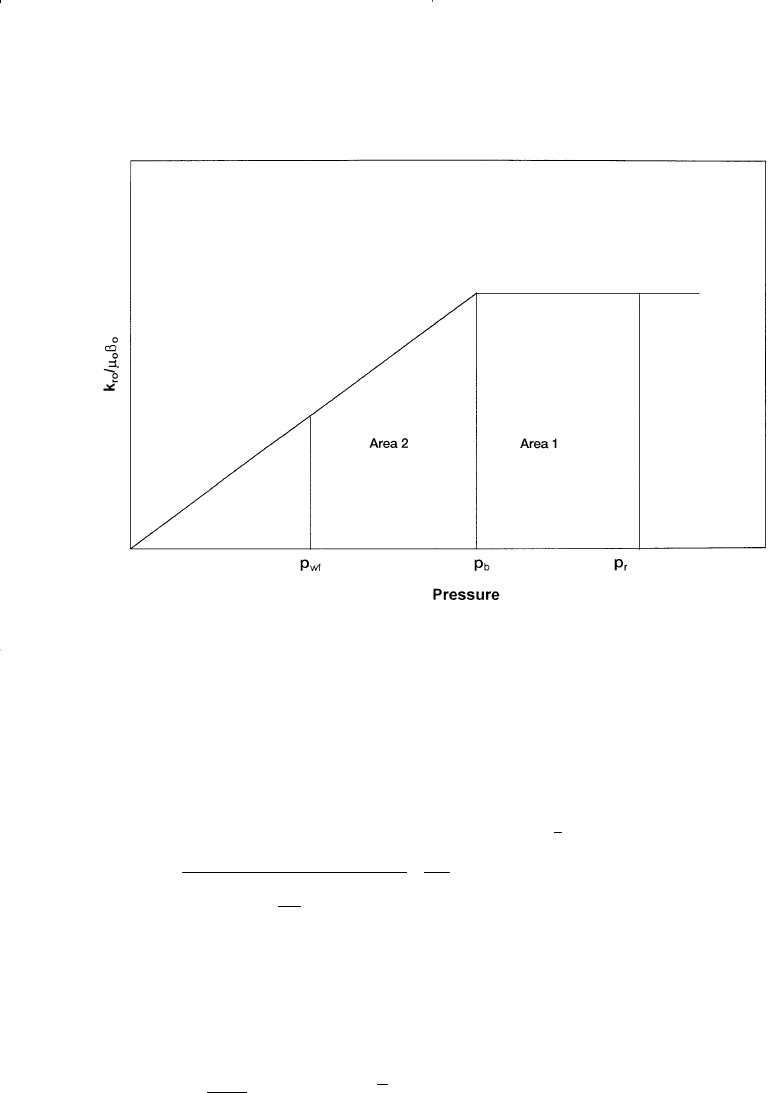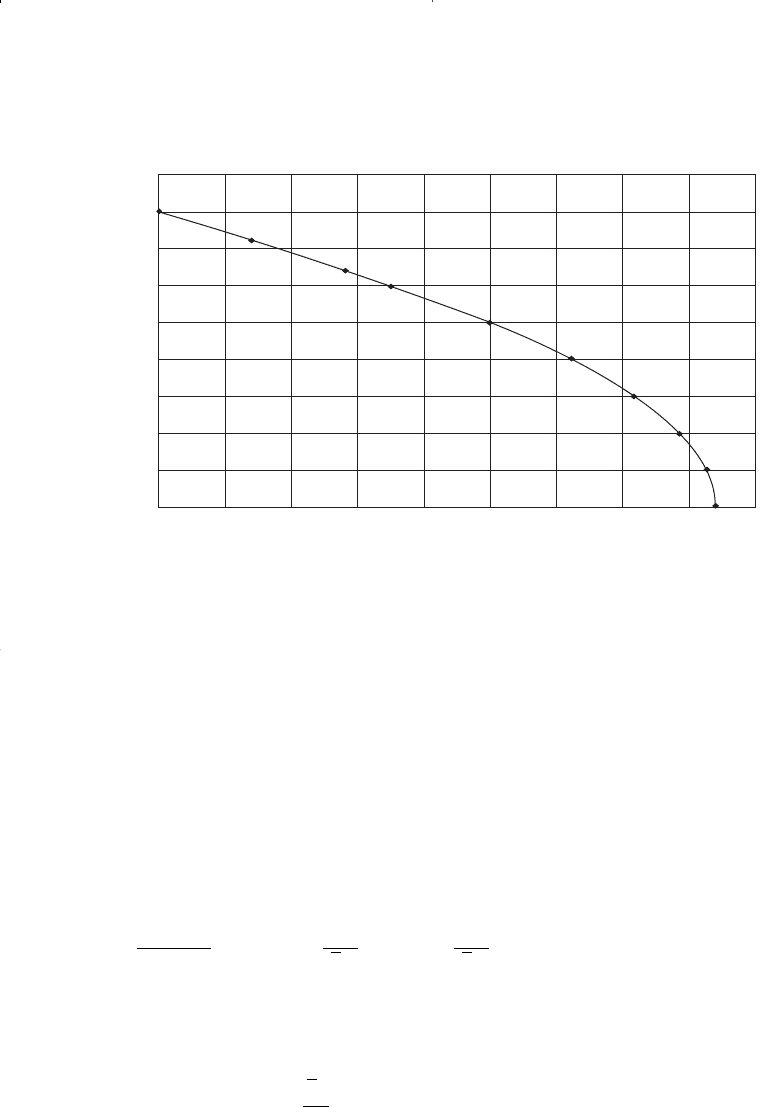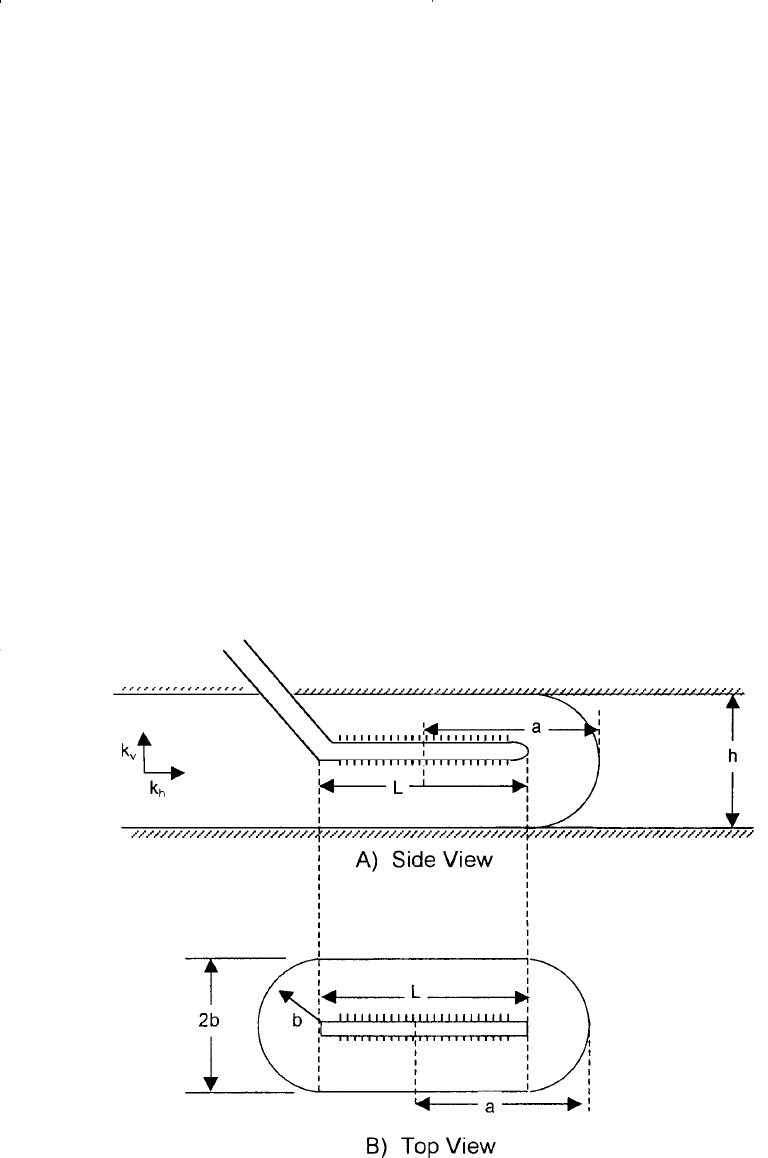Tarek Ahmed. Reservoir engineering handbook
Подождите немного. Документ загружается.


and n
b
as the values of the performance coefficient and the flow exponent
at the bubble-point pressure p
b
, Klins and Clark introduced the following
dimensionless parameters:
• Dimensionless performance coefficient = C/C
b
• Dimensionless flow exponent = n/n
b
• Dimensionless average reservoir pressure = p
–
r
/p
b
The authors correlated (C/C
b
) and (n/n
b
) to the dimensionless pressure
by the following two expressions:
and
where C
b
= performance coefficient at the bubble-point pressure
n
b
= flow exponent at the bubble-point pressure
The procedure of applying the above relationships in adjusting the coef-
ficients C and n with changing average reservoir pressure is detailed below:
Step 1. Using the available flow-test data in conjunction with Fetkovich’s
equation, i.e., Equation 7-34, calculate the present (current) val-
ues of n and C at the present average pressure p
–
r
.
Step 2. Using the current values of p
–
r
, calculate the dimensionless values
of (n/n
b
) and (C/C
b
) by applying Equations 7-37 and 7-38,
respectively.
C
C
p
p
p
p
p
p
b
r
b
r
b
r
b
Ê
Ë
Á
ˆ
¯
˜
=- -
Ê
Ë
Á
ˆ
¯
˜
+-
Ê
Ë
Á
ˆ
¯
˜
--
Ê
Ë
Á
ˆ
¯
˜
1 3 5718 1 4 7981 1
2 3066 1
2
3
..
. (7 - 38)
n
n
p
p
p
p
p
p
b
r
b
r
b
r
b
Ê
Ë
Á
ˆ
¯
˜
=+ -
Ê
Ë
Á
ˆ
¯
˜
--
Ê
Ë
Á
ˆ
¯
˜
+-
Ê
Ë
Á
ˆ
¯
˜
1 0 0577 1 0 2459 1
0 503 1
2
3
..
.
(7 - 37)
508 Reservoir Engineering Handbook
Reservoir Eng Hndbk Ch 07 2001-10-24 16:50 Page 508

Step 3. Solve for the constants n
b
and C
b
from:
and
It should be pointed out that if the present reservoir pressure
equals the bubble-point pressure, the values of n and C as calcu-
lated in Step 1 are essentially n
b
and C
b.
Step 4. Assume future average reservoir pressure p
–
r
and solve for the cor-
responding future dimensionless parameters (n
f
/n
b
) and (C
f
/C
b
)
by applying Equations 7-37 and 7-38, respectively.
Step 5. Solve for future values of n
f
and C
f
from
n
f
= n
b
(n/n
b
)
C
f
= C
b
(C
f
/C
b
)
Step 6. Use n
f
and C
f
in Fetkovich’s equation to generate the well’s future
IPR at the desired average reservoir pressure (p
–
r
)
f
. It should be
noted that the maximum oil flow rate (Q
o
)
max
at (p
–
r
)
f
is given by:
(Q
o
)
max
= C
f
[(p
–
r
)
2
]
n
f
(7-41)
Example 7-10
Using the data given in Example 7-9, generate the future IPR data
when the reservoir pressure drops to 3200 psi.
Solution
Step 1. Since the reservoir exists at its bubble-point pressure, then:
n
b
= 0.854 and C
b
= 0.00079 at p
b
= 3600 psi
C
C
CC
b
b
=
(/ )
(7 - 40)
n
n
nn
b
b
=
/
(7 - 39)
Oil Well Performance 509
Reservoir Eng Hndbk Ch 07 2001-10-24 16:50 Page 509

Step 2. Calculate the future dimensionless parameters at 3200 psi by
applying Equations 7-37 and 7-38:
Step 3. Solve for n
f
and C
f
:
n
f
= (0.854) (1.0041) = 0.8575
C
f
= (0.00079) (0.6592) = 0.00052
Therefore, the flow rate is expressed as:
Q
o
= 0.00052 (32002 - p
2
wf
)
0.8575
When the maximum oil flow rate, i.e., AOF, occurs at p
wf
= 0, then:
(Q
o
)
max
= 0.00052 (3200
2
- 0
2
)
0.8575
= 534 STB/day
Step 4. Construct the following table:
p
wf
Q
o
3200 0
2000 349
1500 431
500 523
0 534
Figure 7-14 compares current and future IPRs as calculated in Exam-
ples 7-9 and 7-10.
C
C
b
Ê
Ë
Á
ˆ
¯
˜
=- -
Ê
Ë
ˆ
¯
+-
Ê
Ë
ˆ
¯
--
Ê
Ë
ˆ
¯
=
1 3 5718 1
3200
3600
4 7981 1
3200
3600
2 3066 1
3200
3600
0 6592
2
3
..
..
n
n
b
Ê
Ë
Á
ˆ
¯
˜
=+ -
Ê
Ë
ˆ
¯
--
Ê
Ë
ˆ
¯
+-
Ê
Ë
ˆ
¯
=
1 0 0577 1
3200
3600
0 2459 1
3200
3600
0 5030 1
3200
3600
1 0041
2
3
..
..
510 Reservoir Engineering Handbook
Reservoir Eng Hndbk Ch 07 2001-10-24 16:50 Page 510

Case 3: p
–
r
> p
b
and p
wf
< p
b
Figure 7-15 shows a schematic illustration of Case 3 in which it is
assumed that p
wf
< p
b
and p
–
r
> p
b
. The integral in Equation 7-25 can be
expanded and written as:
Substituting Equations 7-27 and 7-18 into the above expression gives:
Q
kh
r
r
s
B
p
p
dp
B
dp
o
e
w
oo b oo
pb
p
r
p
wf
p
b
=
Ê
Ë
Á
ˆ
¯
˜
-+
Ê
Ë
Á
ˆ
¯
˜
Ê
Ë
Á
ˆ
¯
˜
+
Ê
Ë
Á
ˆ
¯
˜
È
Î
Í
Í
˘
˚
˙
˙
ÚÚ
0 00708
075
11.
ln .
mm
Q
kh
r
r
s
fpdp fpdp
o
e
w
p
b
p
r
p
wf
p
b
=
Ê
Ë
Á
ˆ
¯
˜
-+
+
È
Î
Í
Í
˘
˚
˙
˙
ÚÚ
0 00708
075
.
ln .
() ()
Oil Well Performance 511
500
0
0
1000
1500
2000
2500
3000
3500
4000
100 200 300 400 500 600 700 800 900 1000
Flow Rate (STB/Day)
Pressure (psi)
Current IPR
Future IPR
Figure 7-14. IPR.
Reservoir Eng Hndbk Ch 07 2001-10-24 16:50 Page 511

where m
o
and B
o
are evaluated at the bubble-point pressure p
b
.
Arranging the above expression gives:
Integrating and introducing the productivity index J into the above
relationship gives:
QJ
p
pp pp
o
b
bwf rb
=-+-
È
Î
Í
˘
˚
˙
1
2
22
()()
Q
kh
B
r
r
s
p
pdp dp
o
oo
e
w
b
p
b
p
r
p
wf
p
b
=
Ê
Ë
Á
ˆ
¯
˜
-+
È
Î
Í
Í
˘
˚
˙
˙
+
È
Î
Í
Í
˘
˚
˙
˙
ÚÚ
0 00708
075
1.
ln .m
512 Reservoir Engineering Handbook
Figure 7-15. (k
ro
/m
o
B
o
) vs. pressure for Case #3.
Reservoir Eng Hndbk Ch 07 2001-10-24 16:50 Page 512

or
Example 7-11
The following reservoir and flow-test data are available on an oil well:
• Pressure data: p
–
r
= 4000 psi p
b
= 3200 psi
• Flow test data: p
wf
= 3600 psi Q
o
= 280 STB/day
Generate the IPR data of the well.
Solution
Step 1. Calculate the productivity index from the flow-test data.
Step 2. Generate the IPR data by applying Equation 7-30 when the
assumed p
wf
> p
b
and using Equation 7-42 when p
wf
< p
b
.
p
wf
Equation Q
o
4000 (7-30) 0
3800 (7-30) 140
3600 (7-30) 280
3200 (7-30) 560
3000 (7-42) 696
2600 (7-42) 941
2200 (7-42) 1151
2000 (7-42) 1243
1000 (7-42) 1571
500 (7-42) 1653
0 (7-42) 1680
Results of the calculations are shown graphically in Figure 7-16.
It should be pointed out Fetkovich’s method has the advantage over
Standing’s methodology in that it does not require the tedious material
J STB day psi=
-
=
280
4000 3600
07.//
QJpp
J
p
pp
orb
b
bwf
=-+ -() ( )
2
22
(7 - 42)
Oil Well Performance 513
Reservoir Eng Hndbk Ch 07 2001-10-24 16:50 Page 513

balance calculations to predict oil saturations at future average reservoir
pressures.
The Klins-Clark Method
Klins and Clark (1993) proposed an inflow expression similar in form
to that of Vogel’s and can be used to estimate future IPR data. To
improve the predictive capability of Vogel’s equation, the authors intro-
duced a new exponent d to Vogel’s expression. The authors proposed the
following relationships:
where
d
p
p
p
r
b
b
=+
Ê
Ë
Á
ˆ
¯
˜
È
Î
Í
Í
˘
˚
˙
˙
+
(
)
0 28 0 72 1 24 0 001. . . . (7 - 44)
Q
Q
p
p
p
p
o
o
wf
r
wf
r
d
(
)
=-
Ê
Ë
Á
ˆ
¯
˜
-
Ê
Ë
Á
ˆ
¯
˜
max
..1 0 295 0 705 (7 - 43)
514 Reservoir Engineering Handbook
500
0
0
1000
1500
2000
2500
3000
3500
4000
4500
200 400 600 800 1000 1200 1400 1600 1800
Q
o
, STB/day
Pressure (psi)
Figure 7-16. IPR using the Fetkovich method.
Reservoir Eng Hndbk Ch 07 2001-10-24 16:50 Page 514

The computational steps of the Klins and Clark are summarized
below:
Step 1. Knowing the bubble-point pressure and the current reservoir pres-
sure, calculate the exponent d from Equation 7-44.
Step 2. From the available stabilized flow data, i.e., Q
o
at p
wf
, solve
Equation 7-43 for (Q
o
)
max
.
Step 3. Construct the current IPR by assuming several values of p
wf
in
Equation 7-43 and solving for Q
o
.
HORIZONTAL OIL WELL PERFORMANCE
Since 1980, horizontal wells began capturing an ever-increasing share
of hydrocarbon production. Horizontal wells offer the following advan-
tages over those of vertical wells:
• Large volume of the reservoir can be drained by each horizontal well.
• Higher productions from thin pay zones.
• Horizontal wells minimize water and gas zoning problems.
• In high permeability reservoirs, where near-wellbore gas velocities are
high in vertical wells, horizontal wells can be used to reduce near-well-
bore velocities and turbulence.
• In secondary and enhanced oil recovery applications, long horizontal
injection wells provide higher injectivity rates.
• The length of the horizontal well can provide contact with multiple
fractures and greatly improve productivity.
The actual production mechanism and reservoir flow regimes around
the horizontal well are considered more complicated than those for the
vertical well, especially if the horizontal section of the well is of a con-
siderable length. Some combination of both linear and radial flow actual-
ly exists, and the well may behave in a manner similar to that of a well
that has been extensively fractured. Several authors reported that the
shape of measured IPRs for horizontal wells is similar to those predicted
by the Vogel or Fetkovich methods. The authors pointed out that the pro-
ductivity gain from drilling 1,500-foot-long horizontal wells is two to
four times that of vertical wells.
Oil Well Performance 515
Reservoir Eng Hndbk Ch 07 2001-10-24 16:50 Page 515

A horizontal well can be looked upon as a number of vertical wells
drilling next to each other and completed in a limited pay zone thickness.
Figure 7-17 shows the drainage area of a horizontal well of length L in a
reservoir with a pay zone thickness of h. Each end of the horizontal well
would drain a half-circular area of radius b, with a rectangular drainage
shape of the horizontal well.
Assuming that each end of the horizontal well is represented by a ver-
tical well that drains an area of a half circle with a radius of b, Joshi
(1991) proposed the following two methods for calculating the drainage
area of a horizontal well.
Method I
Joshi proposed that the drainage area is represented by two half circles
of radius b (equivalent to a radius of a vertical well r
ev
) at each end and a
rectangle, of dimensions L(2b), in the center. The drainage area of the
horizontal well is given then by:
516 Reservoir Engineering Handbook
Figure 7-17. Horizontal well drainage area.
Reservoir Eng Hndbk Ch 07 2001-10-24 16:50 Page 516

where A = drainage area, acres
L = length of the horizontal well, ft
b = half minor axis of an ellipse, ft
Method II
Joshi assumed that the horizontal well drainage area is an ellipse and
given by:
with
where a is the half major axis of an ellipse.
Joshi noted that the two methods give different values for the drainage
area A and suggested assigning the average value for the drainage of the
horizontal well. Most of the production rate equations require the value
of the drainage radius of the horizontal well, which is given by:
where r
eh
= drainage radius of the horizontal well, ft
A = drainage area of the horizontal well, acres
Example 7-11
A 480-acre lease is to be developed by using 12 vertical wells. Assum-
ing that each vertical well would effectively drain 40 acres, calculate the
possible number of either 1,000- or 2,000-ft-long horizontal wells that
will drain the lease effectively.
r
A
eh
=
43 560,
p
a
L
b=+
2
(7 - 47)
A
ab
=
p
43 560,
(7 - 46)
A
Lb b
=
(
)
+2
43 560
2
p
,
(7 - 45)
Oil Well Performance 517
Reservoir Eng Hndbk Ch 07 2001-10-24 16:50 Page 517
